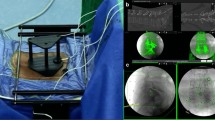Abstract
Background
Endoscopically assisted screw fixation with lumbar interbody fusion is rarely performed. We succeeded in implanting the cortical bone trajectory (CBT) screws under the guidance of unilateral biportal endoscopy (UBE).
Method
We attempted endoscopically assisted screw fixation in a patient with degenerative spondylolisthesis. Through a third portal, ipsilateral CBT screws were implanted without complications.
Conclusions
We successfully performed unilateral biportal endoscopic lumbar interbody fusion (ULIF) with CBT and reversed CBT screws. Compared with percutaneous pedicle screw (PPS) placement, this procedure is a minimally invasive, endoscopic alternative that allows precise screw placement.





Similar content being viewed by others
Data availability
The original data and material presented in the study are included in the article/Supplementary Material; further inquiries can be directed to the corresponding author.
Code availability
Not applicable.
References
Hohenhaus M, Watzlawick R, Masalha W, Volz F, Scholz C, Hubbe U, Klingler JH (2021) Cranial facet joint injuries in percutaneous lumbar pedicle screw placement: a matched-pair analysis comparing intraoperative 3D navigation and conventional fluoroscopy. European Spine J 30(1):88–96. https://doi.org/10.1007/s00586-020-06467-8
Jarvers JS, Schleifenbaum S, Pfeifle C, Oefner C, Edel M, von der Höh N, Heyde CE (2021) Comparison of three different screw trajectories in osteoporotic vertebrae: a biomechanical investigation. BMC Musculoskelet Disord 22(1):418. https://doi.org/10.1186/s12891-021-04254-0
Mobbs RJ, Sivabalan P, Li J (2011) Technique, challenges and indications for percutaneous pedicle screw fixation. J Clin Neurosci 18(6):741–749. https://doi.org/10.1016/j.jocn.2010.09.019
Matsukawa K, Yato Y (2017) Lumbar pedicle screw fixation with cortical bone trajectory: a review from anatomical and biomechanical standpoints. Spine Surg Relat Res 1(4):164–173. https://doi.org/10.22603/ssrr.1.2017-0006
Zhu C, Liang J, Pan H, Zhang W (2023) Far lateral lumbar interbody fusion with unilateral pedicle screw fixation and double traversing cages using a biportal endoscopic technique. Acta Neurochir 165(8):2165–2169. https://doi.org/10.1007/s00701-023-05702-7
Zhu C, Zhang L, Pan H, Zhang W (2022) Lumbar interbody fusion with bilateral cages using a biportal endoscopic technique with a third portal. Acta Neurochir 164(9):2343–2347. https://doi.org/10.1007/s00701-022-05324-5
Funding
This work was supported by the National Key R&D Program of China (2019YFC0121400).
Author information
Authors and Affiliations
Contributions
Conceptualization: WZ and HP; methodology: WZ; resources: JL; writing—original draft preparation: CZ; writing—review and editing: WZ; supervision: WZ and HP; project administration: WZ. All authors contributed to the article and approved the submitted version.
Corresponding author
Ethics declarations
Ethics approval
The studies involving human participants were reviewed and approved by the Institutional Review Board of Hangzhou Traditional Chinese Medicine Hospital Affiliated with Zhejiang Chinese Medical University.
Consent to participate
The patients provided their written informed consent to participate in this study.
Consent for publication
Written informed consent was obtained from the patient for publication of this technical note and any accompanying images.
Conflict of interest
The authors declare no competing interests.
Additional information
Publisher's Note
Springer Nature remains neutral with regard to jurisdictional claims in published maps and institutional affiliations.
Key points
1. We successfully performed unilateral biportal endoscopic-assisted cortical trajectory screw fixation (ULIF).
2. By performing a contralateral facetectomy through the third portal [6], theoretically, it is also possible to achieve endoscopic CBT and reversed CBT screw implantation on the contralateral side.
3. In endoscopic CBT and reversed CBT screw implantation, the surgical field is small, and adequate exposure of an accurate entry point minimizes the risk of muscle and facet joint injury while reducing operative time and radiation exposure.
4. The cortical bone at the entry point can be entered using an endoscopic high-speed burr to avoid slipping when inserting screws.
5. The CBT screw can be safely inserted by an assistant on the contralateral side under endoscopic monitoring.
6. The screw was first inserted on the right side to avoid obstructing the view for endoscopic observation.
7. The strength of solid CBT screws may be greater than that of hollow pedicle screws.
8. When the screw-rod system is inserted, it is advisable to suture the working portal temporarily to prevent the formation of a vortex, which may cause the surgical field to appear blurry.
9. The “stop irrigation test” was helpful in determining the bleeding points, and complete haemostasis was recommended to prevent epidural haematoma formation.
10. Extensive experience in biportal endoscopic lumbar interbody fusion has aided in performing this new procedure.
Supplementary Information
Below is the link to the electronic supplementary material.
Supplementary file1 (MP4 18540 KB)
Rights and permissions
Springer Nature or its licensor (e.g. a society or other partner) holds exclusive rights to this article under a publishing agreement with the author(s) or other rightsholder(s); author self-archiving of the accepted manuscript version of this article is solely governed by the terms of such publishing agreement and applicable law.
About this article
Cite this article
Zhu, C., Liang, J., Pan, H. et al. Biportal endoscopic-assisted cortical bone trajectory screw placement and lumbar interbody fusion. Acta Neurochir 166, 74 (2024). https://doi.org/10.1007/s00701-024-05986-3
Received:
Accepted:
Published:
DOI: https://doi.org/10.1007/s00701-024-05986-3




